Understanding Parrot Behavior: The Importance of Standing
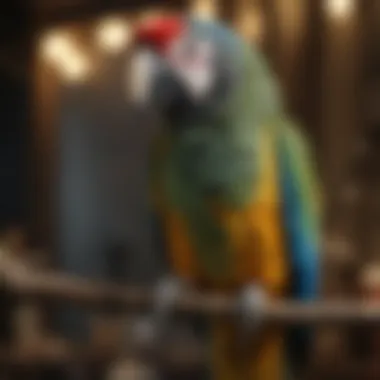
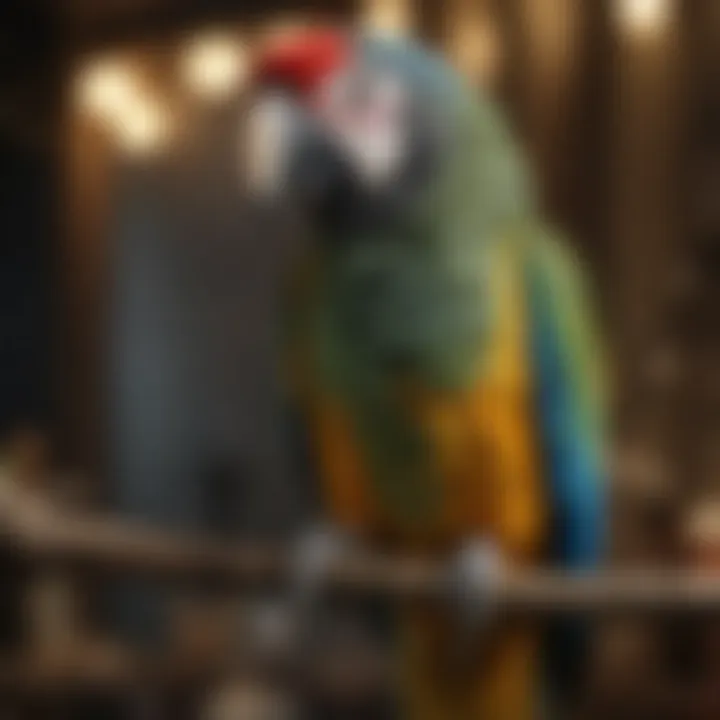
Intro
Understanding the behavior of parrots offers insights into their health and social dynamics. Within this exploration, standing emerges as a critical behavior that deserves attention. By observing how parrots stand, owners can interpret health and emotional states, as well as assess their environmental interactions. This narrative aims to dissect the significance of standing in the daily life of parrots, benefiting both pet owners and avian enthusiasts alike.
Understanding Your Pet
Understanding a parrot's behavior is essential for effective care. Knowing the basics of pet behavior, breed characteristics, and species-specific needs aids owners in providing a nurturing environment.
Pet Behavior Basics
Parrots communicate through body language. Standing, for instance, can indicate mood and comfort. A relaxed stance usually suggests security, while a tense posture may reflect stress or fear. By paying attention to these signals, owners can better cater to their pet’s emotional and physical needs.
Common Breed Characteristics
Different parrot breeds exhibit distinct standing behaviors. For example, African Grey parrots tend to perch confidently, signaling comfort in their space. Conversely, smaller species may display more cautious stances, especially when in new environments. Understanding these differences helps tailor care and interaction strategies to individual birds.
Species-Specific Needs
Species-specific needs play a vital role in how parrots stand and behave. Larger parrots require ample space to stretch and move. Smaller parrots may thrive in intimate settings with close interaction. Monitoring these factors ensures that each parrot can express its natural behavior safely and comfortably.
Pet Care and Maintenance
Proper care and maintenance are paramount for a parrot's wellbeing. This section covers feeding guidelines, grooming essentials, and hygiene practices that influence their standing behavior and overall health.
Feeding Guidelines
Balanced diets are crucial for keeping parrots healthy. Each species has unique dietary requirements. Fresh fruits, vegetables, seeds, and pellets should form the bulk of their diet. Inadequate nutrition can lead to health issues, impacting their energy levels and willingness to stand.
Grooming Essentials
Regular grooming contributes to physical comfort. This includes nail trimming to prevent overgrowth, which can affect how a parrot stands. Also, feather care is important for maintaining proper insulation and mobility. Lack of proper grooming can lead to distress, often reflected in standing posture.
Hygiene Practices
Maintaining cleanliness in their environment is vital. Regular cage cleaning prevents the buildup of waste and bacteria, contributing to a parrot's general health. A clean space encourages the natural standing and movement behaviors they need for physical and mental stimulation.
Training and Development
Training affects how parrots stand and behave. Developing basic commands, employing behavioral techniques, and addressing common issues fosters an environment conducive to healthy standing.
Basic Commands and Skills
Teaching a parrot fundamental commands helps build trust and understanding. Positive reinforcement can encourage confident standing behavior, which is crucial in their interaction with humans and other pets.
Behavioral Training Techniques
Utilizing various training techniques promotes a parrot’s positive behaviors. Understanding reward systems that appeal to parrots can lead to improved standing habits and overall engagement.
Addressing Common Behavior Issues
Common behavioral issues, such as anxiety when standing, can be addressed through consistent training. By identifying triggers and providing support, owners can help their birds feel secure in their environment.
Health and Wellness
Health is directly linked to a parrot's ability to stand comfortably. Regular vet check-ups and awareness of vaccination needs are essential aspects of their care.
Routine Vet Check-ups
Regular visits to a veterinarian help monitor health. Routine check-ups ensure that standing-related health issues are caught early, allowing for timely interventions and treatments.
Vaccination Needs
Keeping up with vaccinations safeguards against common illnesses. Healthy parrots are more likely to exhibit normal standing behaviors, while illness can lead to lethargy and changes in posture.
Recognizing Signs of Illness
Pet owners must learn to recognize signs of illness, which can directly affect standing. Decreased activity, poor balance, or body slumping are indicators of potential health issues that require attention.
Enrichment and Activities
Engaging activities enrich a parrot's life and can influence their willingness to stand confidently.
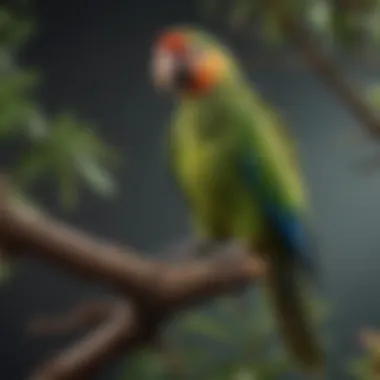
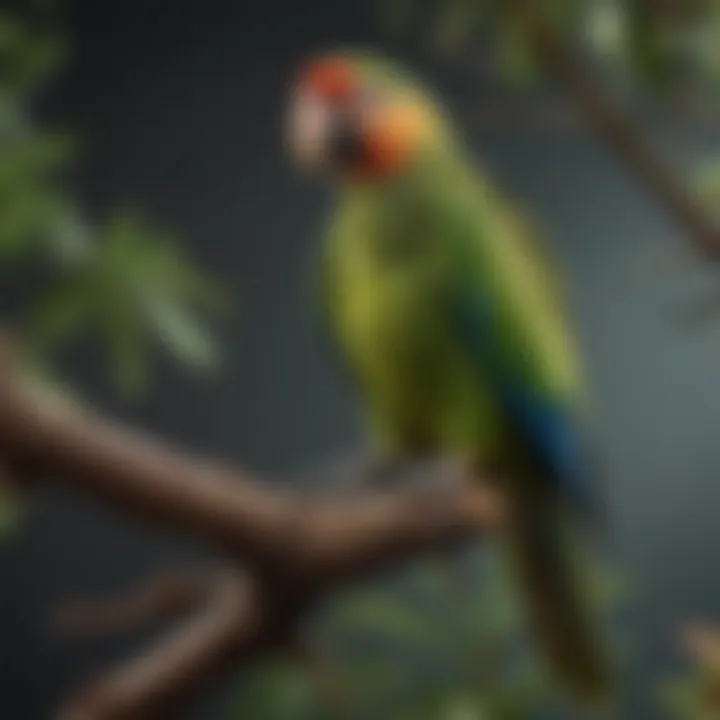
Indoor vs.
Outdoor Activities
Both indoor and outdoor activities are important. Indoor play areas should be safe and filled with toys that encourage standing and climbing. Outdoor exposure offers natural stimuli that promote active standing and exploration.
Interactive Toys and Games
Interactive toys stimulate mental and physical activity. Birds that enjoy these toys demonstrate increased confidence in standing and moving around their cages or perches.
Socialization Opportunities
Socialization enhances a parrot's confidence, impacting their behavior. Regular interaction with humans and other birds helps them feel secure, promoting normal standing postures and social behaviors.
Understanding a parrot's standing behavior is more than just observing; it's about comprehending their overall health and emotional wellbeing.
The Basics of Parrot Physiology
Parrots are fascinating creatures, known for their intelligent behaviors and colorful plumage. Understanding their physiology is essential in appreciating how these birds operate, especially when it comes to their behavior related to standing. Not only does physiology shape their physical capabilities, it also influences their health and wellbeing.
Understanding Parrot Anatomy
The anatomy of parrots is uniquely adapted for their needs. Their bodies are designed to fly, perch, and interact with their environment effectively. Parrots have a lightweight skeletal structure that supports agility and mobility. Their beak is strong and curved, enabling them to crack open seeds, which is a crucial part of their diet.
In addition to the beak, the feet are significant anatomical features. Parrots possess zygodactyl feet, meaning they have two toes facing forwards and two facing backward. This configuration allows for a strong grip on branches and supports their standing posture. Understanding these aspects of anatomy is important to gauge normal standing behavior and recognize potential issues if a parrot appears unsteady or has trouble standing.
Musculoskeletal System
The musculoskeletal system of parrots plays a vital role in their standing behavior. The bones are lightweight, aiding in flight. Muscles are well-developed, particularly in the legs, which help them maintain balance while standing. A parrot's ability to stand indicates a healthy musculoskeletal system, as strength and coordination are critical for this behavior.
When observing standing behavior, one should consider the overall condition of the parrot. If a parrot shows signs of fatigue or weakness in standing, this may be indicative of underlying health problems. It is important for pet owners to ensure that their bird has ample opportunities to exercise and strengthen its muscles through thoughtful enrichment activities. A proper understanding of the musculoskeletal system can help in identifying any issues that may arise.
Understanding parrot anatomy and musculoskeletal health is crucial for effective bird care, particularly in relation to their standing behaviors and overall wellbeing.
By grasping these basic physiological concepts, pet owners can provide better care, ensuring their parrots are healthy, happy, and capable of expressing natural behaviors.
The Concept of Standing in Parrots
The behavior of standing is a fundamental aspect of parrot physiology and social interactions. Understanding this concept sheds light on how parrots engage with their environment and interact with each other. Standing is not merely a default posture; it serves several important purposes in the lives of these avian creatures.
Defining Standing Behavior
Standing behavior in parrots refers to the act of being upright on their feet while maintaining balance and stability. It involves the use of their strong leg muscles, predominantly powered by their unique musculoskeletal system. The posture reflects various emotions and physical states. For example, a parrot standing tall may show confidence and comfort in its surroundings. In contrast, a parrot that is hunched or uneasy may indicate stress or discomfort. This behavior can also vary depending on factors such as the bird’s mood and environmental conditions.
"Standing not only signifies physical stability but also emotional balance for parrots."
Standing vs.
Other Positions
When comparing standing to other positions, such as perching or sitting, it becomes clear that standing is a dynamic behavior. Unlike passive sitting, standing involves active muscle engagement, suggesting readiness for action, interaction, or escape if necessary.
- Perching:
- Sitting:
- Stretching:
- While perching can be considered a relaxed stance, it differs from standing as it often involves resting, using less energy.
- Perching is also more stable, allowing the bird to rest without exerting much effort.
- This position can be quite sedentary and indicates that a parrot is at ease.
- Prolonged sitting may indicate inactivity or lethargy, which may need attention.
- Stretching often follows standing and is an important part of maintaining muscle health.
- This behavior helps keep the muscles flexible and reduces stiffness.
Reasons Why Parrots Stand
Parrots, like many animals, exhibit specific behaviors that can shed light on their welfare and social dynamics. Understanding why parrots stand is essential for any pet owner, as it encompasses aspects of physical comfort, social interactions, and awareness of their environment. Engaging with these factors not only enhances the relationship between parrots and their owners but also contributes to the overall health and wellbeing of these birds.
Physical Comfort and Stability
When a parrot stands, it often signifies a sense of physical comfort and stability. This behavior allows them to distribute their weight evenly, reducing fatigue compared to other positions such as perching or hanging. A properly designed perch can support this standing behavior, as the right diameter and texture ensure that the parrot feels secure.
Consider the following elements that contribute to the physical comfort of parrots when standing:
- Foot Health: Healthy standing promotes good foot health, which is crucial for their long-term wellbeing.
- Balance: Standing provides a stable base, allowing parrots to maintain balance while they engage in other activities, such as grooming or observing their surroundings.
- Muscle Tone: Regular standing helps strengthen their leg and core muscles. This muscle development is important for overall agility and movement.
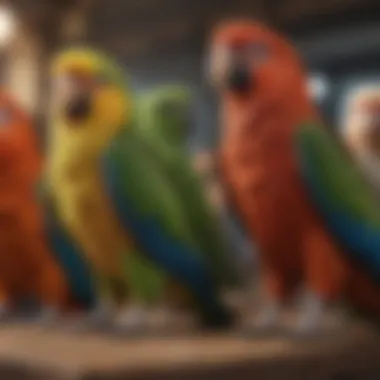
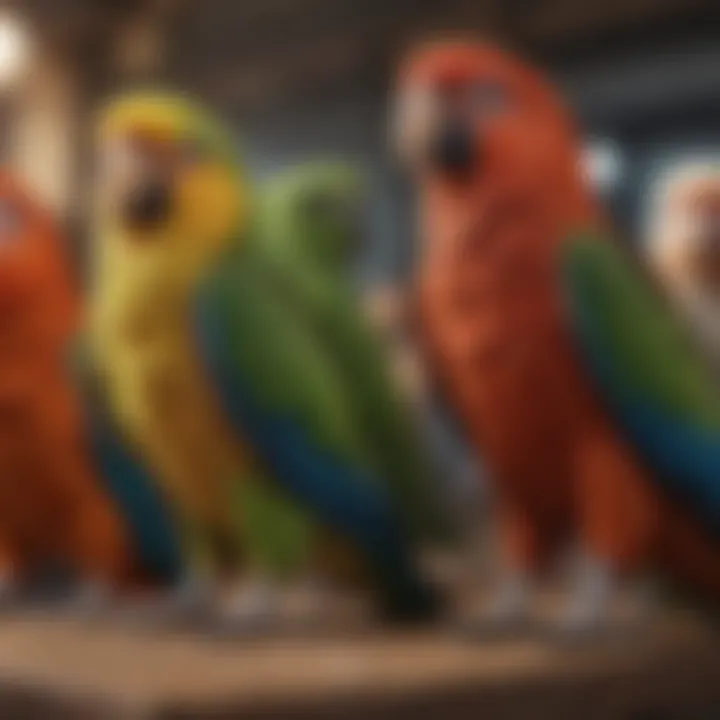
Understanding these factors can inform cage design and the selection of perches that cater to the standing behavior of parrots, ultimately promoting better health.
Social Interactions
In many species of parrots, standing is also a crucial component of social interactions. Parrots often choose to stand close to one another when interacting. This behavior can enhance bonding and communication between them, allowing for a sense of security within a flock.
Some key considerations regarding social interactions include:
- Hierarchy: Standing positions may signify dominance or submission during interactions. Higher standing positions can indicate a dominant parrot, while others may opt for lower positions to avoid conflict.
- Grooming: Many times, standing actually precedes grooming behaviors. Parrots often stand side by side as part of mutual grooming, which fosters social bonds and reinforces trust.
- Playfulness: Standing can prompt playful behaviors, inviting other parrots into an engaging and interactive setting.
Exploring social dynamics can aid owners in providing a more enriching environment that encourages healthy interactions among parrots.
Environmental Awareness
Standing plays a significant role in a parrot's awareness of its environment. It allows them to effectively survey their surroundings, spotting potential threats or food sources.
Several elements contribute to environmental awareness while standing:
- Vantage Point: From a standing position, parrots can survey their environment from a height, helping them assess proximity to other flocks or predators.
- Alertness: Standing often indicates alertness, as parrots are more likely to maintain vigilance while stationary. This behavioral trait reduces stress levels by facilitating their overview of the environment.
- Exploration: Lastly, standing can serve as a precursor to exploration. When feeling secure, a parrot may choose to explore more by moving from a standing position.
Thus, understanding the significance of standing behavior can enhance the living spaces of pet owners, ensuring that parrots feel safe and engaged in their environments.
Proper standing not only speaks to the comfort of parrots but also reflects their social structures and environmental awareness. Adjusting care strategies around this behavior can significantly impact a parrot's quality of life.
Standing and Health Indicators
Standing behavior in parrots serves as more than just a simple physical act; it reveals significant insights into their health and wellbeing. A parrot's posture can indicate various aspects of their health status and state of mind. Understanding these indicators is vital for pet owners, as it helps in the early detection of potential health issues and informs better care practices.
Key elements to consider include how a parrot stands, the duration of their standing, and the context in which this behavior occurs. A parrot that stands upright with a balanced posture typically indicates good health. In contrast, any shifts toward unusual or strained postures might warrant closer observation.
Assessing Posture for Health Insights
To assess a parrot's health effectively, attention must be paid to their standing posture. An upright position often suggests that the parrot is comfortable and feels secure in its environment. If a parrot frequently leans or appears to have difficulty maintaining balance while standing, these could be signs of underlying health issues:
- Joint pain: Arthritis or other musculoskeletal disorders may cause discomfort, affecting how they stand.
- Neurological conditions: If a parrot struggles to maintain balance, it might indicate a neurological problem that needs evaluation by a veterinarian.
- Respiratory distress: Sometimes, difficulty in standing properly may link to breathing difficulties, requiring prompt attention.
Monitoring regular changes in these postures allows owners to identify behavioral shifts that correlate with health transitions.
Signs of Distress in Standing Behavior
Parrots, like other animals, communicate their feelings and health states through body language. Specific standing behaviors can signal distress or discomfort. Understanding these signs can be crucial for timely interventions to ensure the parrot's overall health and safety. Key indicators include:
- Hunched posture: A parrot that tucks its head and body in close may be feeling unwell or insecure.
- Wobbling: Frequent swaying or unsteady movements while standing might indicate issues such as fatigue or neurological problems.
- Fluffed feathers: When a parrot stands with puffed-out feathers, it may be feeling cold or unwell, signaling that something is off.
By being aware of these signs, owners can take proactive measures to improve their parrot's living conditions or seek veterinary care when necessary.
"Understanding a parrot's standing behavior can reveal much about their health, helping owners intervene appropriately to maintain their pets' well-being."
The Role of Standing in Training
Standing serves multiple roles in the training of parrots, influencing both the learning process and the bond between the bird and its owner. By understanding how this basic behavior functions in the training context, pet owners can enhance the effectiveness of their training sessions. Observing a parrot's standing behavior can reveal much about its comfort level, readiness to engage, and overall health, which are critical aspects during training.
Utilizing Standing in Commands
Utilizing standing as part of training commands can significantly harness a parrot's natural instincts. When a parrot stands in front of its owner, it is in a position of alertness. This posture helps in gaining the bird's full attention. Training commands can be paired with specific standing behaviors. For instance, when teaching the command to
Environmental Factors Influencing Standing
In understanding the behavior of parrots, environmental factors play a crucial role, especially in the context of standing. The physical space in which a parrot lives, including its perches and the overall environment, significantly affects its ability to demonstrate natural standing behavior. This section will discuss essential elements that influence standing, addressing various considerations and benefits related to perch design and cage size.
Perches and Their Design
Perches serve as the primary platform for a parrot's daily activities. The design of these perches can greatly impact how comfortable a parrot feels while standing. Here are some factors that should be taken into account when designing or choosing perches:
- Material: Natural wood perches can replicate the texture and feel of branches in the wild. This is important because it allows parrots to engage their feet more naturally, promoting better grip and balance.
- Diameter: The thickness of the perch should be suitable for the size of the parrot. A perch that is too thin can cause foot strain, while one that is too thick can hinder comfort.
- Variety: Offering a variety of perches at different heights and textures lets parrots switch positions. This can enhance their ability to stand comfortably and breed natural behaviors.
It's necessary to also clean these perches regularly. A clean perch prevents health issues and fosters a favorable standing environment.
Cage Size and Environment
The size of the cage and the overall environment are also critical in influencing standing behavior. A well-designed environment allows parrots to move freely and choose their preferred standing positions. The following points highlight the importance of cage size and environmental considerations:


- Space to Move: A larger cage offers more space for standing, climbing, and playing, which enhances a parrot’s physical well-being. Limited space can lead to stress and poor posture.
- Environmental Enrichment: Facilities like swings, ropes, and toys add complexity to a parrot's environment. These enrichments can motivate parrots to explore various standing positions, improving their overall engagement.
- Visibility and Interaction: An environment that allows visibility to their owners and surroundings can positively influence a parrot’s confidence. Feeling secure while standing can prompt better posture and a more relaxed demeanor.
The Significance of Enrichment
Enrichment plays a vital role in the behavior and well-being of parrots. Providing an enriched environment helps mimic their natural habitat, encouraging healthy behaviors like standing. Without sufficient stimulation, parrots can become bored, leading to stress and potential health issues. Enrichment not only entertains but also promotes physical and mental health. Parrots are intelligent animals; they need challenges that satisfy their curiosity.
Encouraging Natural Standing Behavior
Encouraging natural standing behavior is essential for a parrot's overall health. When parrots stand naturally, it aids in their balance and stability. Positioning perches at varying heights encourages parrots to use their bodies actively.
- Variety of Perches: Use different materials like wood and plastic. This allows parrots to choose their preferred texture, promoting comfort and natural standing.
- Height Variability: Perches of different heights stimulate their instinct to stand and interact with other birds. This can strengthen social bonds and prevent loneliness.
Natural behaviors lead to a satisfied parrot, less prone to behavioral issues.
Toys and Activities for Engagement
Incorporating toys and activities is critical for engagement. Toys promote standing and other natural behaviors. They keep parrots mentally active, preventing boredom. Activities can include foraging and climbing, which are both stimulating and beneficial.
- Foraging Toys: These toys require parrots to work for treats, mirroring their wild behavior. They can stand comfortably while accessing the toys.
- Interactive Games: Games that require standing, like hide and seek, promote physical engagement. They also allow parrots to exercise their intelligence.
Engagement through toys reinforces positive behavior, contributing to a parrot’s well-being. The right enrichment can make a significant difference in how a parrot feels and behaves.
Cultural Considerations in Parrot Care
Understanding cultural considerations in parrot care is vital for anyone looking to provide a loving and supportive environment for these intelligent birds. Parrots originate from diverse habitats, and each species comes with its unique needs influenced by their native cultures. In this section, we will explore what these needs are and how they relate to standing behavior as well as community practices that shape their care.
Understanding Different Species’ Needs
Each parrot species has specific requirements that stem from its natural habitat. For example, the African Grey Parrot thrives in an environment rich in mental stimulation due to its high level of intelligence. Adequate standing positions for African Greys will often reflect their need for security and mental engagement. Their typical behaviors include standing tall and perceptively observing their surroundings. This behavior indicates a healthy balance between comfort and alertness.
Conversely, the Macaw species often exhibits more extroverted standing behaviors, which can signal their need for social interaction. Their standing posture is not merely functional; it demonstrates confidence when interacting with human caregivers or other birds. Recognizing these innate differences helps owners cater to the individual needs of their parrots, ensuring that their environment encourages both physical and psychological well-being.
Community Practices and Trends
Community practices surrounding parrot care can significantly influence how these birds are raised and their overall standing behavior. Driven by collective experience, pet owners across various cultures share their insights on optimal parrot care. For instance, some communities emphasize the importance of spacious cages and diverse environments, allowing parrots room to display their standing behaviors naturally. Such setups promote both physical exercise and mental enrichment.
Social media platforms like Reddit and Facebook have become valuable resources for parrot owners. These platforms create communities where enthusiasts exchange tips about standing practices and care. The trends that arise from these discussions can lead to better understanding and acceptance of varied care practices, including how to address different species' needs.
Regularly engaging with fellow parroters can lead to enriching discussions that improve your understanding of your bird's behaviors and the community’s overall approach to care.
Ending: The Importance of Standing Behavior
Understanding the significance of standing behavior in parrots is crucial for optimizing both their health and wellbeing. Standing is not just a means of stability but also serves various important functions in a parrot's daily life. Recognizing these roles can help parrot owners create an environment that promotes positive standing behaviors while being vigilant of potential health indicators.
Standing can reflect a parrot's comfort levels, social dynamics, and awareness of their surroundings. When parrots maintain a proper standing posture, it indicates both physical health and a balanced mental state. Conversely, irregular standing may hint at distress, discomfort, or other underlying health issues. Thus, it becomes essential for owners to observe and understand these behaviors closely.
Moreover, the implications of understanding standing go beyond just health. Parrots thrive in environments that cater to their natural instincts. These include appropriate perches and engaging activities. When owners facilitate such environments, it naturally encourages better standing postures, contributing to their overall happiness.
Benefits of recognizing the importance of standing behavior include:
- Enhanced monitoring of health indicators.
- Improved training success through positive reinforcement.
- Greater insight into environmental adaptations.
Each of these aspects contributes to a more fulfilling life for parrots, which, in turn, enriches the relationship between pet and owner.
Understanding a parrot's behavior, particularly standing, enables owners to meet the animals' needs effectively. A deeper awareness fosters stronger bonds and contributes to a bird's overall wellbeing.
Implications for Parrot Ownership
The implications of understanding standing behavior are vast and multifaceted for parrot owners. First, owners must comprehend that standing is intrinsic to a parrot's physical health. Regular monitoring of their standing postures can provide early warnings for potential health issues, allowing for prompt veterinary care when needed.
Additionally, creating a habitat that encourages natural standing behaviors is essential. This involves offering a variety of perches that suit the bird’s size and species. Perches should vary in texture, diameter, and height to simulate the natural environments these birds are accustomed to.
Moreover, social interaction plays a pivotal role in a parrot's life. Standing near their owners or other birds fosters healthy social habits. Regular engagement in such activities nurtures a sense of security, leading to better-standing behavior.
In summary:
- Regular postural assessments can preempt health declines.
- Diverse perching options support natural standing habits.
- Social interaction is vital for emotional balance.
Further Research Directions
While this article provides considerable insights into standing behavior among parrots, further research is necessary. Studies could explore the long-term effects of different types of perches on standing behavior and overall wellbeing. Additionally, examining variations in standing behavior across species can yield valuable data for owners.
Research into the psychological effects of standing and other body postures would further elucidate their significance. Scholars should also consider the impact of environmental factors like cage size and layout on standing behavior.
In future explorations, it would be beneficial to examine the effects of social structures within flocks on individual standing behaviors. Understanding these dimensions can help improve care practices and enrichment activities for pet owners.
Thus, the quest for knowledge about parrot behavior continues. As we delve into these areas, improvements in parrot wellbeing and care will follow.







